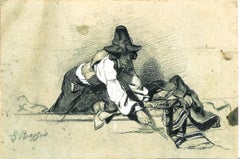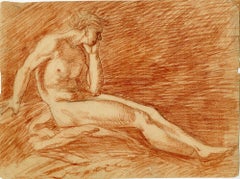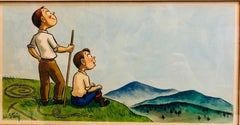Giuseppe Raggio Drawings and Watercolor Paintings
Italian, 1823-1916
Giuseppe Raggio was born in Chiavari and while his father wished him to join the merchant marine, by 1845, he had decided to study painting and participated in his first exhibition in Genoa. Raggio enrolled in the Accademia di Belle Arti of Florence, where he studied under the neoclassical painter Giuseppe Bezzuoli.
to
1
Overall Width
to
Overall Height
to
1
1
1
1
1
1
1
1
3
922
406
282
279
1
Artist: Giuseppe Raggio
Il Buttero (The Cowboy) - Ink and White Lead by Giuseppe Raggio - 1920 ca.
By Giuseppe Raggio
Located in Roma, IT
Beautiful ink drawing and white lead by Giuseppe Raggio, probably belonging to his last years of artistic activity.
Good conditions.
This artwork is shipped from Italy. Under existi...
Category
1910s Naturalistic Giuseppe Raggio Drawings and Watercolor Paintings
Materials
Ink
Related Items
Life study of a male nude in repose - European School, late 18th Century
Located in Middletown, NY
European School, late 18th century. Red chalk with primo pensiero in graphite on cream laid paper, 8 1/2 x 11 1/2 inches (215 x 293 mm). Scattered light handling wear and multiple s...
Category
Late 18th Century Naturalistic Giuseppe Raggio Drawings and Watercolor Paintings
Materials
Chalk, Laid Paper, Pencil, Graphite
Whimsical Illustration Hiking Cartoon, 1938 Mt Tremblant Ski Lodge William Steig
By William Steig (b.1907)
Located in Surfside, FL
Lighthearted Illustration of Outdoor Pursuits This one being cross country hiking signed "W. Steig"
Provenance: from Mrs. Joseph B. Ryan, Commissioned by Joe Ryan for the bar at his ski resort, Mount Tremblant Lodge, in 1938.
Mont Tremblant, P.Q., Canada
Watercolor and ink on illustration board, sights sizes 8 1/2 x 16 1/2 in., framed.
In 1938 Joe Ryan, described as a millionaire from Philadelphia, bushwhacked his way to the summit of Mont Tremblant and was inspired to create a world class ski resort at the site. In 1939 he opened the Mont Tremblant Lodge, which remains part of the Pedestrian Village today. This original illustration is on Whatman Illustration board. the board measures 14 X 22 inches. label from McClees Galleries, Philadelphia, on the frame backing paper.
William Steig, 1907 – 2003 was an American cartoonist, sculptor, and, in his later life, an illustrator and writer of children's books. Best known for the picture books Sylvester and the Magic Pebble, Abel's Island, and Doctor De Soto, he was also the creator of Shrek!, which inspired the film series of the same name. He was the U.S. nominee for both of the biennial, international Hans Christian Andersen Awards, as a children's book illustrator in 1982 and a writer in 1988.
Steig was born in Brooklyn, New York in 1907, and grew up in the Bronx. His parents were Polish-Jewish immigrants from Austria, both socialists. His father, Joseph Steig, was a house painter, and his mother, Laura Ebel Steig, was a seamstress who encouraged his artistic leanings. As a child, he dabbled in painting and was an avid reader of literature. Among other works, he was said to have been especially fascinated by Pinocchio.He graduated from Townsend Harris High School at 15 but never completed college, though he attended three, spending two years at City College of New York, three years at the National Academy of Design and a mere five days at the Yale School of Fine Arts before dropping out of each.
Hailed as the "King of Cartoons" Steig began drawing illustrations and cartoons for The New Yorker in 1930, producing more than 2,600 drawings and 117 covers for the magazine. Steig, later, when he was 61, began writing children's books. In 1968, he wrote his first children's book. He excelled here as well, and his third book, Sylvester and the Magic Pebble (1969), won the Caldecott Medal. He went on to write more than 30 children's books, including the Doctor DeSoto series, and he continued to write into his nineties. Among his other well-known works, the picture book Shrek! (1990) formed the basis for the DreamWorks Animation film Shrek (2001). After the release of Shrek 2 in 2004, Steig became the first sole-creator of an animated movie franchise that went on to generate over $1 billion from theatrical and ancillary markets after only one sequel. Along with Maurice Sendak, Saul Steinberg, Ludwig Bemelmans and Laurent de Brunhofff his is one of those rare cartoonist whose works form part of our collective cultural heritage.
In 1984, Steig's film adaptation of Doctor DeSoto directed by Michael Sporn was nominated for the Academy Award for Best Animated Short Film. As one of the most admired cartoonists of all time, Steig spent seven decades drawing for the New Yorker magazine. He touched generations of readers with his tongue–in–cheek pen–and–ink drawings, which often expressed states of mind like shame, embarrassment or anger. Later in life, Steig turned to children's books, working as both a writer and illustrator.
Steig's children's books were also wildly popular because of the crazy, complicated language he used—words like lunatic, palsied, sequestration, and cleave. Kids love the sound of those words even if they do not quite understand the meaning. Steig's descriptions were also clever. He once described a beached whale as "breaded with sand."
Throughout the course of his career, Steig compiled his cartoons and drawings into books. Some of them were published first in the New Yorker. Others were deemed too dark to be printed there. Most of these collections centered on the cold, dark psychoanalytical truth about relationships. They featured husbands and wives fighting and parents snapping at their kids. His first adult book, Man About Town, was published in 1932, followed by About People, published in 1939, which focused on social outsiders. Sick of Each Other, published in 2000, included a drawing depicting a wife holding her husband at gunpoint, saying, "Say you adore me."
According to the Los Angeles Times, fellow New Yorker artist Edward Sorel...
Category
1930s Naturalistic Giuseppe Raggio Drawings and Watercolor Paintings
Materials
Archival Ink, Watercolor, Illustration Board
Blanche et Noire
By (After) Henri Toulouse Lautrec
Located in Cliffside Park, NJ
Blanche et Noire, de l'album «Toulouse-Lautrec, douze lithographies»
52,2 x 35,9 cm
Category
1890s Naturalistic Giuseppe Raggio Drawings and Watercolor Paintings
Materials
Lithograph
Charcoal Drawing Abstract Teeth Bone Erica Child Prudhomme American Woman Artist
Located in Surfside, FL
Tooth (from Bone Drawings series)
1994
charcoal drawing on paper
11 x 14 inches
Charcoal study of abstract teeth (perfect for a dentist office!)
Erica Prudhomme learned some of the basics from her artist father and his brother, Charles and Paul Child...
Category
1990s Naturalistic Giuseppe Raggio Drawings and Watercolor Paintings
Materials
Paper, Charcoal
Whimsical Illustration Skiing Cartoon, 1938 Mt Tremblant Ski Lodge William Steig
By William Steig (b.1907)
Located in Surfside, FL
Lighthearted Illustration of Outdoor Pursuits This one being a Skiing scene, a boy and a girl on skis. signed W. Steig
Provenance: from Mrs. Joseph B. Ryan, Commissioned by Joe Ryan for the bar at his ski resort, Mount Tremblant Lodge, in 1938.
Mont Tremblant, P.Q., Canada
Watercolor and ink on illustration board, sights sizes 8 1/2 x 16 1/2 in., framed.
In 1938 Joe Ryan, described as a millionaire from Philadelphia, bushwhacked his way to the summit of Mont Tremblant and was inspired to create a world class ski resort at the site. In 1939 he opened the Mont Tremblant Lodge, which remains part of the Pedestrian Village today. This original illustration is on Whatman Illustration board. the board measures 14 X 22 inches. label from McClees Galleries, Philadelphia, on the frame backing paper.
William Steig, 1907 – 2003 was an American cartoonist, sculptor, and, in his later life, an illustrator and writer of children's books. Best known for the picture books Sylvester and the Magic Pebble, Abel's Island, and Doctor De Soto, he was also the creator of Shrek!, which inspired the film series of the same name. He was the U.S. nominee for both of the biennial, international Hans Christian Andersen Awards, as a children's book illustrator in 1982 and a writer in 1988.
Steig was born in Brooklyn, New York in 1907, and grew up in the Bronx. His parents were Polish-Jewish immigrants from Austria, both socialists. His father, Joseph Steig, was a house painter, and his mother, Laura Ebel Steig, was a seamstress who encouraged his artistic leanings. As a child, he dabbled in painting and was an avid reader of literature. Among other works, he was said to have been especially fascinated by Pinocchio.He graduated from Townsend Harris High School at 15 but never completed college, though he attended three, spending two years at City College of New York, three years at the National Academy of Design and a mere five days at the Yale School of Fine Arts before dropping out of each.
Hailed as the "King of Cartoons" Steig began drawing illustrations and cartoons for The New Yorker in 1930, producing more than 2,600 drawings and 117 covers for the magazine. Steig, later, when he was 61, began writing children's books. In 1968, he wrote his first children's book. He excelled here as well, and his third book, Sylvester and the Magic Pebble (1969), won the Caldecott Medal. He went on to write more than 30 children's books, including the Doctor DeSoto series, and he continued to write into his nineties. Among his other well-known works, the picture book Shrek! (1990) formed the basis for the DreamWorks Animation film Shrek (2001). After the release of Shrek 2 in 2004, Steig became the first sole-creator of an animated movie franchise that went on to generate over $1 billion from theatrical and ancillary markets after only one sequel. Along with Maurice Sendak, Saul Steinberg, Ludwig Bemelmans and Laurent de Brunhofff his is one of those rare cartoonist whose works form part of our collective cultural heritage.
In 1984, Steig's film adaptation of Doctor DeSoto directed by Michael Sporn was nominated for the Academy Award for Best Animated Short Film. As one of the most admired cartoonists of all time, Steig spent seven decades drawing for the New Yorker magazine. He touched generations of readers with his tongue–in–cheek pen–and–ink drawings, which often expressed states of mind like shame, embarrassment or anger. Later in life, Steig turned to children's books, working as both a writer and illustrator.
Steig's children's books were also wildly popular because of the crazy, complicated language he used—words like lunatic, palsied, sequestration, and cleave. Kids love the sound of those words even if they do not quite understand the meaning. Steig's descriptions were also clever. He once described a beached whale as "breaded with sand."
Throughout the course of his career, Steig compiled his cartoons and drawings into books. Some of them were published first in the New Yorker. Others were deemed too dark to be printed there. Most of these collections centered on the cold, dark psychoanalytical truth about relationships. They featured husbands and wives fighting and parents snapping at their kids. His first adult book, Man About Town, was published in 1932, followed by About People, published in 1939, which focused on social outsiders. Sick of Each Other, published in 2000, included a drawing depicting a wife holding her husband at gunpoint, saying, "Say you adore me."
According to the Los Angeles Times, fellow New Yorker artist Edward Sorel...
Category
1930s Naturalistic Giuseppe Raggio Drawings and Watercolor Paintings
Materials
Archival Ink, Watercolor, Illustration Board
French Nude Woman Seated on a Bench Study
By Emile Lejeune
Located in Houston, TX
Nude woman seated on a bench looking out at the viewer. The work is signed by the artist and stamped. The paper is not framed.
Many others are available. Please inquire to buy the e...
Category
1950s Naturalistic Giuseppe Raggio Drawings and Watercolor Paintings
Materials
Graphite
"SOMEWHERE ELSE #2", Watercolor on Sal Leaf Plate, Black Frame, Green, Red, Tan
By Eva Ennist
Located in Toronto, Ontario
Eva Ennist, a mixed media and fiber artist, travels extensively through the Far East, gathering materials and techniques for her practice. The artwork "SOMETHING ELSE #2" uses materi...
Category
21st Century and Contemporary Naturalistic Giuseppe Raggio Drawings and Watercolor Paintings
Materials
Watercolor, Organic Material, Wood, Found Objects, Mixed Media
$900
H 16 in W 16 in D 2 in
Early Portrait of a French Woman
By Emile Lejeune
Located in Houston, TX
Naturalistic portrait of a french woman with a styled hair cut. The work is signed and dated by the artist. The paper is not framed.
Many others are available. Please inquire to buy the entire collection.
Artist Biography: Emile Lejeune...
Category
1930s Naturalistic Giuseppe Raggio Drawings and Watercolor Paintings
Materials
Color Pencil, Graphite
Reclining Naturalistic Nude Woman Study
By Emile Lejeune
Located in Houston, TX
Reclining nude study of a woman with her leg up on the bed and her eyes closed. The work is signed by the artist. The paper is not framed.
Many others are available. Please inquire ...
Category
1950s Naturalistic Giuseppe Raggio Drawings and Watercolor Paintings
Materials
Graphite
Untitled Naturalistic Portrait of a Musician
By Stanley Clark
Located in Houston, TX
Untitled naturalist portrait of a musician with a guitar. The work is signed by the artist in the bottom corner and the work is not currently framed.
Art...
Category
Late 20th Century Naturalistic Giuseppe Raggio Drawings and Watercolor Paintings
Materials
Charcoal
Naturalistic Study of a Standing Nude Woman
By Emile Lejeune
Located in Houston, TX
A naturalistic study of a nude woman standing with her back to the viewer. She appears to be gripping the corner of something. The work is signed and dated by the artist. The paper is not framed.
Many others are available. Please inquire to buy the entire collection.
Artist Biography: Emile Lejeune...
Category
1950s Naturalistic Giuseppe Raggio Drawings and Watercolor Paintings
Materials
Graphite
$1,200
H 18.88 in W 12.38 in D 0.001 in
[CHINESE EXPORT WATERCOLOURS ON PITH PAPER]. - Botanical Studies
Located in London, GB
[CHINESE EXPORT WATERCOLOURS ON PITH PAPER].
A Group of 10 Flowers and Butterflies.
mid to late nineteeenth century.
A fine group of Chines...
Category
Late 19th Century Naturalistic Giuseppe Raggio Drawings and Watercolor Paintings
Materials
Watercolor, Gouache, Rice Paper
$19,310
H 10.63 in W 15.56 in D 0.79 in
Giuseppe Raggio drawings and watercolor paintings for sale on 1stDibs.
Find a wide variety of authentic Giuseppe Raggio drawings and watercolor paintings available for sale on 1stDibs. You can also browse by medium to find art by Giuseppe Raggio in ink and more. Not every interior allows for large Giuseppe Raggio drawings and watercolor paintings, so small editions measuring 12 inches across are available. Customers who are interested in this artist might also find the work of Michele Cascarano, Emile Lejeune, and Adrienne Sherman. Giuseppe Raggio drawings and watercolor paintings prices can differ depending upon medium, time period and other attributes. On 1stDibs, the price for these items starts at $1,604 and tops out at $1,604, while the average work can sell for $1,604.


